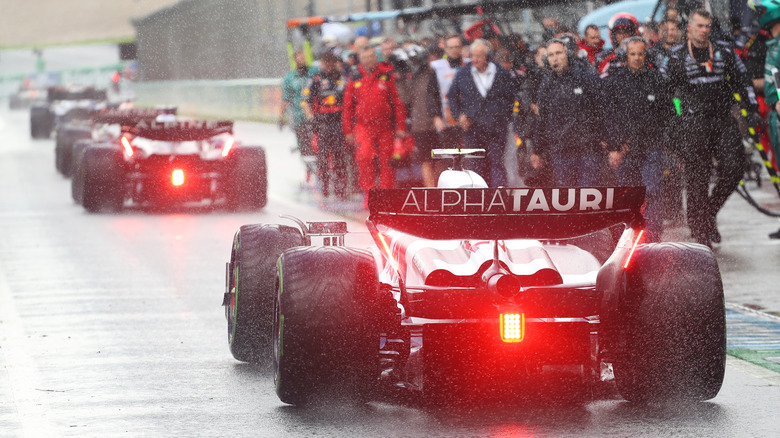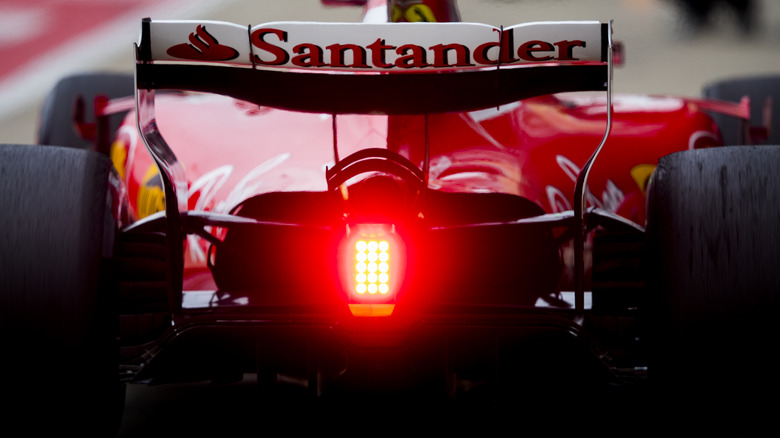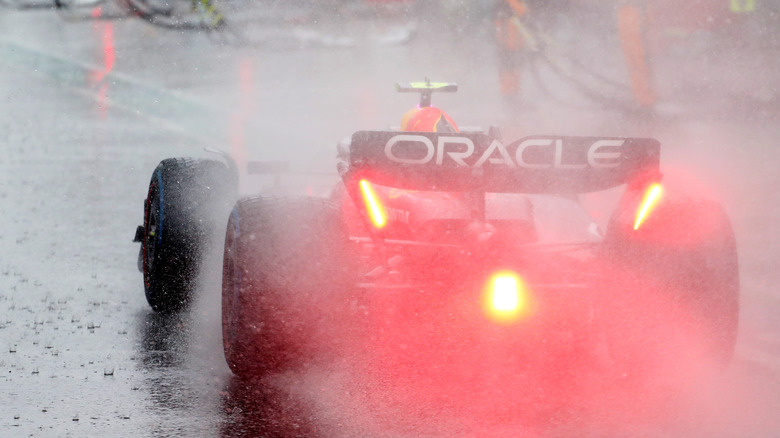What Is The Red Flashing Light At The Back Of An F1 Car For?
Formula One safety devices have come a long way since the sport's inaugural season in 1950. But as cars get faster and more demanding, this equipment likewise must be bleeding-edge to match. Drivers rely on sight more than any of the other five senses, and this is particularly true in racing — certainly in Formula One, where the cars go well over 200 mph. Even fans new to Formula 1 will notice the lone cluster of bright red (occasionally flashing) LEDs on the rear of the cars that don't operate like the taillights on road cars.
An F1 car's rear light cluster performs two main functions. First (and most obviously), it informs the drivers behind where a car is on the track, acting like an aircraft's navigation lights along with the marker lights on the wing stalks. A F1 car's rear light also flashes to indicate that it is harvesting energy to be used by its Motor Generator Units (MGU-K, for kinetic, and MGU-H, for heat). An F1 car's MGUs store useful energy produced by the brake and exhaust systems and deploy it in specific zones on the track. With about 160 horsepower of total extra boost, this is essentially the same as bolting a Toyota Corolla engine to the rear wheels, providing the car with added power at key moments. When the system is banking energy or fully depleted, a car will be slower than expected. Under these conditions, the car's rear light will flash as a warning to other drivers.
The MGU-K and energy harvesting
Pretend that you're a racing driver coming out of a slow corner onto a long straightaway, and there's a car right in front of you. Logic dictates that the car's going to accelerate at about the same rate as yours. But that doesn't always happen, particularly when one car is still in the process of recovering energy. That's what the blinking light is for. While everyone knows that a regular car's brake light means that it is rapidly decelerating, the blinking light on an F1 car means that it's not accelerating as quickly as you'd expect.
This is crucial because a car not moving as quickly as others on the track can be a significant safety hazard. And drivers can't all use their additional hybrid power at the same pace; F1 cars are only allowed to use 2 Megajoules of energy stored in the MGU-K per lap. This makes every deployment a strategic call, as poor energy management can have a profound effect on lap times; especially at higher-speed tracks like Monza. It will be even more dramatic when new F1 engine regulations take effect in 2026.
In other words, if an F1 driver has energy to deploy and sees that the car ahead has a red blinking rear light, it informs them that their opponent is recovering brake or exhaust energy, and therefore moving slowly. This alerts the driver behind to be aware of the closing gap and potential danger or opportunity to overtake. Without the rear light, drivers would have to rely more on instinct and guesswork, likely leading to more on-track incidents.
The rear light also helps with visibility in the rain
Next, imagine that you're driving behind a truck on a rainy highway without windshield wipers (F1 cars don't them, or even complete windshields). That's what driving these cars in the rain can be like when you're running close behind another car — you can't see a thing through the spray. If something unexpected comes up ahead on the track, drivers have a fraction of a second to react. Some of the tragedies that changed Formula 1 forever have come in wet conditions, and when the track is wet and visibility is low, races can be red-flagged. Remember that these cars have no driver assist systems like anti-lock brakes or traction control, either, meaning they're exceptionally tricky to drive in the rain.
Racing in the rain requires F1 drivers to use speed and line variation. Pavement is porous, so water normally sinks into the track instead of forming puddles on the surface. But heavy braking zones get coated with a layer of rubber from the tires, so the water gathers in these critical spots, causing cars to hydroplane. Drivers will use alternate lines to avoid these puddles of standing water, making racing in the rain even more unpredictable. Some drivers are also simply better than others in the rain, leading to dramatic speed discrepancies and unanticipated maneuvers. F1 drivers know where turns and braking zones should be because of the various visible reference points alongside the track, but they can't always tell precisely where the other cars are. The central red light and marker lights on the wing provide more visual cues, acting as beacons so drivers can see other cars through the spray.


